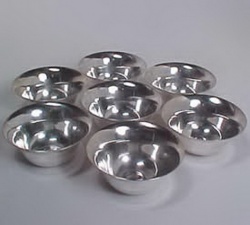Seven Water Bowl Offerings
The traditional set of offerings, commonly represented by bowls of water, derives from the customary offerings presented to an honoured guest in ancient India. The first bowl contains clear water for the newly arrived guests to drink. The water should be imagined as pure as nectar and offered in vessels made of precious substances. In the second bowl is water for the guest to wash his or her feet; a reminder that in India people walked barefoot. In the third bowl are flowers, reminiscent of the crowns of flowers offered to women and the garlands offered to men. Masses of fragrant, beautiful flowers can be called up in the imagination. In the fourth bowl is incense, an offering to please the sense of smell. In the imagination billowing clouds of fragrant incense are offered. The fifth offering, pleasing to sight, is bright light commonly in the form of a lamp, which like the sun and the moon illuminates darkness. This light is imagined to be so clear that you can see even the smallest atoms without obstruction. Sometimes coloured lights are offered and imagined to be emanating from nectar. In Bhutanese tradition different colours are believed to have various healing properties. Coloured or not, the light offered should be very clear. Light is imagined as dispelling the darkness of ignorance. Shariputra, the Buddha’s main disciple renowned for his intelligence, had, in a previous life, offered a bright light before a stupa. As a result he was reborn with great intelligence. The sixth offering consists of a bowl of scented water. Intended to soothe the mind, it is applied at the heart. Seventh is an offering of food, commonly in the form of a torma or ritual cake. In India, this offering traditionally contained three sweet substances: molasses, honey and sugar and three white substances: curd, butter and milk. In Bhutan, these would be mixed with tsampa or parched barley flour to make an offering cake. The result is like ambrosia, pleasing in colour, form, smell, and taste. Eighth is an offering of sound. It is not represented on the altar, but can simply be imagined as beautiful music.
